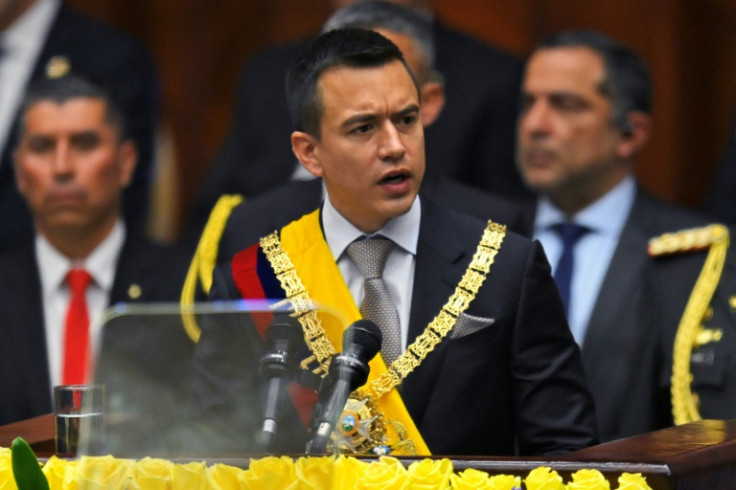
Ecuador vaulted to the global limelight on Tuesday following an surge of violence from different criminal organizations across the country. Images of face-covered gang members taking over a TV station broadcasting live, a national university and several prisons quickly made waves around the world, prompting questions about the extent of the danger.
President Daniel Noboa, who took office less than two months ago, declared an "internal armed conflict" only a day after announcing a state of emergency as a result of the escape of one of the country's main drug lords, illustrating escalating volatility. The latest measure allows Noboa to declare these groups as terrorist organizations and "non-state belligerent actors," mobilizing armed forces to neutralize them.
En estos momentos integrantes de una banda delictiva acaba de tomarse las instalaciones de canal 10 TC television y tomaron de rehenes a todos los empleados de dicha empresa.
— Guayaco sin paro (@sinparoguayaco) January 9, 2024
ECUADOR SOS 🆘 pic.twitter.com/ykt6L1KQU4
Moreover, neighboring Peru declared a state of emergency in its northern border, saying it will strengthen the area to prevent violence from spilling over into its territory.
The conflict has garnered global attention over the past day, but Ecuador has been on a slippery slope during the past years, its homicide rate for 2023 climbing over 500% compared to 2019 and even including Fernando Villavicencio, who was running for the presidency.
Here's a look at the timeline of how violence has overrun Ecuador lately and the main events that led to the current situation.
1. When did the unrest start to escalate?
According to a recount by The Associated Press, a prison riot in 2021 can be considered illustrative of a change of paradigm in Ecuador. In February of that year, a massacre in a prison in Guayaquil, considered to be the most violent of the country, left at least 79 people dead.
However, unrest had began about two months earlier with the death of a drug lord from Los Choneros band, catalyzing a series of high-profile clashes between criminal organizations fighting for turf and drug-trafficking routes.
A similar event in September of that year became the worst prison massacre in the country's history, with 119 inmates dead across different locations across Ecuador. The outlet recounted 18 prison clashes with over 450 deaths, being prisons a key control center of organized crime in the country.
These disputes didn't take long to spill over to the streets, exponentially increasing homicide rates. 2023 ended as the most violent year in Ecuador's history, with over 7,600 homicides compared to 2019's 1,187.
Violence started to dominate the public conversation, with the governments of Lenin Moreno (2017-2021) and Guillermo Lasso (2021-2023) unable to quell the issue. After Lasso dissolved Congress and called for new presidential elections in May 2023 to avoid an impeachment against him, most ensuing candidates made of security a key rallying cry.
2. Violence reaches the political high spheres
One of the most outspoken candidates, Fernando Villavicencio, was shot at a campaign event in Quito on August 9, the first time in Ecuador's history that a presidential candidate was assassinated.
Shortly after, people with their faces covered claiming to be members of the Los Lobos cartel said the organization was responsible for the attack. However, then other people, their faces uncovered, said they were actual members of Los Lobos and that they had not assassinated Villavicencio, casting doubt about the true nature of the event.
The murder shook up the campaign and helped propel Noboa, a 35-year-old businessman, to the presidency over Luisa González, an ally of former president Rafael Correa and whose left-leaning party had been at odds with Villavicencio for years.

Noboa took office to finish Lasso's term (until 2025) less than two months ago, promising to eradicate violence through a plan called Phoenix. Less than a week ago he confirmed he would hold a referendum which included proposals such as deploying armed forces at a domestic level.
"We're tired of seeing more protection for criminals than for security officials. We must protect all of those who fight the gangs, so this referendum demands the support of the judiciary so those convicted of being part of criminal organizations see harsher punishments," said Noboa about the security aspect of the measure.
3. Violence escalates
However, the events from the past days led Noboa to first declare the state of emergency, a measure that suspends citizen's rights, imposes a nightly curfew, and permits authorities to mobilize the military internally, and then the "internal armed conflict."
General Cesar Zapata, the national commander of police, said at a press conference on Monday that the armed forces of Ecuador already launched an operation to find Jose Adolfo Macías, also known as "Fito," the country's most-wanted prisoner, who escaped the Guayaquil prison when he was set to be transferred to a high-security facility.
Speaking to The Associated Press, former Ecuadorian minister of Defense Luis Hernandez backed Noboa's actions, as the declaration of internal armed conflict allows him to "use lethal force." He said that it should serve as a clear message to the population so as to not be "subjected to fear and chaos."
© 2023 Latin Times. All rights reserved. Do not reproduce without permission.







